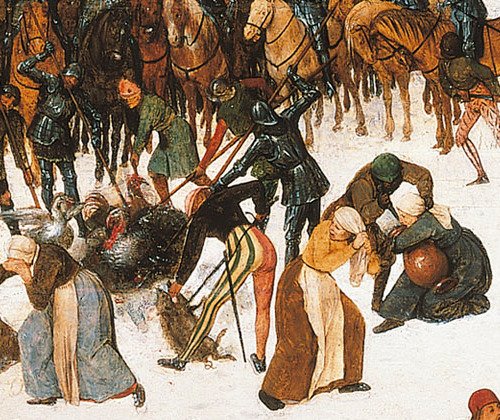I went yesterday to see Bruegel to Rubens — Masters of Flemish Painting at the Queen’s Gallery, Buckingham Palace. I wasn’t really sure what to expect; you have to love Bruegel, but I’ve always found Rubens easier to admire than to enjoy.
It turned out to be just the one Bruegel on show, with seven or eight paintings by Rubens and a variety of other artists: Teniers, van Dyck, Memling and so on. Or to be strictly accurate, only one painting by Pieter Bruegel the Elder; there are a couple by Jan Brueghel the Elder as well. You can see all the paintings on the exhibition website I linked to above.
The Bruegel, Massacre of the Innocents, is a hell of a painting. The biblical story of the massacre ordered by Herod has been painted as set in a Flemish village, with the troops in Spanish costume, making it highly topical, apparently, because the Holy Roman Empire had been cracking down on the Netherlands in brutal fashion. The painting was then acquired by Emperor Rudolph II, who presumably for political reasons had the painting edited: all the massacred babies have been painted over to make the scene one of generic plunder.

So wherever you see a soldier slaughtering an animal, or a woman trying to hold on to a storage jar or a bundle of rags, you know that there was originally an infant. In some places, as in the detail above, you can almost make out what it originally looked like.
It really is one of those occasions when reality seems to be demanding to be used as a metaphor for something, but I shall resist.
The exhibition didn’t persuade me to love Rubens, or at least, not his mythological works or landscapes (though the painting Winter: The interior of a barn pleased me more than most). There were, though, two Rubens portraits which were really fabulous, particularly his self-portrait. Apparently an English nobleman bought a painting from Rubens, and Rubens, not knowing that it was actually intended for the king, fobbed him off with a mediocre work that was mainly painted by his workshop. The self-portrait was the piece he sent to the king as an apology.

It really is a gorgeous piece of work. It doesn’t make me like all those big pink women any more, but this painting at least is very very covetable.
» I got the pictures from this article about the exhibition. The Royal Collection’s website for the show is very good: all the paintings, I think, with commentary, so do check it out.